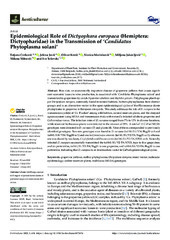Приказ основних података о документу
Epidemiological Role of Dictyophara europaea (Hemiptera: Dictyopharidae) in the Transmission of ‘Candidatus Phytoplasma solani’
| dc.creator | Cvrković, Tatjana | |
| dc.creator | Jovic, Jelena | |
| dc.creator | Krstić, Oliver | |
| dc.creator | Marinković, Slavica | |
| dc.creator | Jakovljević, Miljana | |
| dc.creator | Mitrović, Milana | |
| dc.creator | Tosevski, Ivo | |
| dc.date.accessioned | 2023-07-14T10:15:11Z | |
| dc.date.available | 2023-07-14T10:15:11Z | |
| dc.date.issued | 2022 | |
| dc.identifier.issn | 2311-7524 | |
| dc.identifier.uri | https://plantarum.izbis.bg.ac.rs/handle/123456789/718 | |
| dc.description.abstract | Bois noir, an economically important disease of grapevine yellows that causes significant economic losses in wine production, is associated with ‘Candidatus Phytoplasma solani’ and transmitted to grapevines by cixiids Hyalesthes obsoletus and Reptalus panzeri. Polyphagous planthopper Dictyophara europaea, commonly found in natural habitats, harbors phytoplasmas from distinct groups and is an alternative vector in the open epidemiological cycles of the Flavescence dorée phytoplasma in grapevine in European vineyards. This study addresses the role of D. europaea in the transmission cycle(s) of ‘Ca. P. solani’ among wild habitats, natural reservoir plants, and the vineyard agroecosystem using MLSA and transmission trials with naturally infected adults to grapevine and Catharanthus roseus. The infection rates of D. europaea ranged from 7% to 13% in diverse locations, while reservoir herbaceous plants were infected in the amount of 29%. A total of 13 CaPsol MLSA genotypes were detected in D. europaea (7) and plants (8). Nine of them corresponded to previously identified genotypes. Two new genotypes were found in D. europaea (tuf-b1/S1/V14/Rqg50-sv1 and tuf-b1/S18/V14/Rqg50-sv1) and one in Convolvulus arvensis (tuf-b1/S1/V2-TA/Rqg31-sv1), whereas one was shared by two hosts, Crepis foetida and Daucus carota (tuf-b1/S1/V2-TA/STOL-sv1). Naturally infected D. europaea successfully transmitted the tuf-b1/S1/V2-TA/STOL type to five grapevines and six periwinkles, tuf-b1/S1/V2-TA/Rqg31 to one grapevine, and tuf-b1/S1/V2-TA/Rqg50 to one periwinkle, indicating that D. europaea is an intermediate vector in CaPsol epidemiological cycles. | sr |
| dc.language.iso | en | sr |
| dc.publisher | MDPI Basel | sr |
| dc.relation | info:eu-repo/grantAgreement/MESTD/inst-2020/200010/RS// | sr |
| dc.rights | openAccess | sr |
| dc.rights.uri | https://creativecommons.org/licenses/by/4.0/ | |
| dc.source | Horticulturae | sr |
| dc.subject | grapevine yellows | sr |
| dc.subject | stolbur phytoplasma | sr |
| dc.subject | Dictyophara europaea | sr |
| dc.subject | insect vector | sr |
| dc.subject | molecular epidemiology | sr |
| dc.subject | stolbur reservoir plants | sr |
| dc.subject | multilocus (MLSA) genotypes | sr |
| dc.title | Epidemiological Role of Dictyophara europaea (Hemiptera: Dictyopharidae) in the Transmission of ‘Candidatus Phytoplasma solani’ | sr |
| dc.type | article | sr |
| dc.rights.license | BY | sr |
| dc.citation.issue | 7 | |
| dc.citation.rank | M21 | |
| dc.citation.spage | 654 | |
| dc.citation.volume | 8 | |
| dc.type.version | publishedVersion | sr |
| dc.identifier.doi | 10.3390/horticulturae8070654 | |
| dc.identifier.fulltext | http://plantarum.izbis.bg.ac.rs/bitstream/id/2897/bitstream_2897.pdf | |
| dc.identifier.scopus | 2-s2.0-85137301930 | |
| dc.identifier.wos | 00083144420000 |


